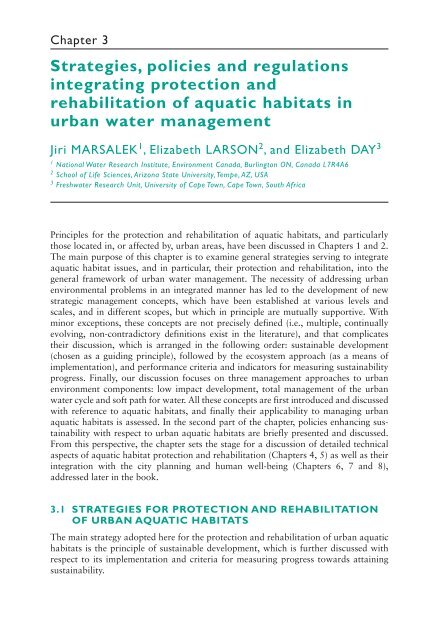Aquatic Habitats In Sustainable Urban Water Management
Aquatic Habitats In Sustainable Urban Water Management
Aquatic Habitats In Sustainable Urban Water Management
- No tags were found...
Create successful ePaper yourself
Turn your PDF publications into a flip-book with our unique Google optimized e-Paper software.
Chapter 3<br />
Strategies, policies and regulations<br />
integrating protection and<br />
rehabilitation of aquatic habitats in<br />
urban water management<br />
Jiri MARSALEK 1 , Elizabeth LARSON 2 , and Elizabeth DAY 3<br />
1 National <strong>Water</strong> Research <strong>In</strong>stitute, Environment Canada, Burlington ON, Canada L7R4A6<br />
2 School of Life Sciences, Arizona State University,Tempe, AZ, USA<br />
3 Freshwater Research Unit, University of Cape Town, Cape Town, South Africa<br />
Principles for the protection and rehabilitation of aquatic habitats, and particularly<br />
those located in, or affected by, urban areas, have been discussed in Chapters 1 and 2.<br />
The main purpose of this chapter is to examine general strategies serving to integrate<br />
aquatic habitat issues, and in particular, their protection and rehabilitation, into the<br />
general framework of urban water management. The necessity of addressing urban<br />
environmental problems in an integrated manner has led to the development of new<br />
strategic management concepts, which have been established at various levels and<br />
scales, and in different scopes, but which in principle are mutually supportive. With<br />
minor exceptions, these concepts are not precisely defined (i.e., multiple, continually<br />
evolving, non-contradictory definitions exist in the literature), and that complicates<br />
their discussion, which is arranged in the following order: sustainable development<br />
(chosen as a guiding principle), followed by the ecosystem approach (as a means of<br />
implementation), and performance criteria and indicators for measuring sustainability<br />
progress. Finally, our discussion focuses on three management approaches to urban<br />
environment components: low impact development, total management of the urban<br />
water cycle and soft path for water. All these concepts are first introduced and discussed<br />
with reference to aquatic habitats, and finally their applicability to managing urban<br />
aquatic habitats is assessed. <strong>In</strong> the second part of the chapter, policies enhancing sustainability<br />
with respect to urban aquatic habitats are briefly presented and discussed.<br />
From this perspective, the chapter sets the stage for a discussion of detailed technical<br />
aspects of aquatic habitat protection and rehabilitation (Chapters 4, 5) as well as their<br />
integration with the city planning and human well-being (Chapters 6, 7 and 8),<br />
addressed later in the book.<br />
3.1 STRATEGIES FOR PROTECTION AND REHABILITATION<br />
OF URBAN AQUATIC HABITATS<br />
The main strategy adopted here for the protection and rehabilitation of urban aquatic<br />
habitats is the principle of sustainable development, which is further discussed with<br />
respect to its implementation and criteria for measuring progress towards attaining<br />
sustainability.















